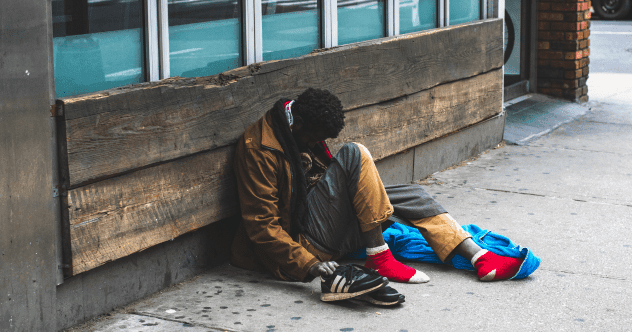In the land of opportunity, a troubling reality persists: homelessness. It’s a crisis affecting people from all walks of life, casting a shadow over the American Dream. Behind the statistics are real stories of struggle and resilience. Let’s delve into some eye-opening facts about homelessness in America and explore the human side of these numbers.
Join us as we confront this sobering truth, humanize the statistics, and explore potential solutions. Perhaps a future where homelessness is a distant memory is within reach, replaced by a commitment to providing shelter, dignity, and hope for everyone.
Unsheltered Homeless Population
While shelters offer a haven, they aren’t a complete solution. According to the National Alliance to End Homelessness, about 40% of homeless individuals live unsheltered as of 2022.
These individuals face the elements, unsafe conditions, and a lack of privacy every day. Imagine the constant struggle for survival, wondering if you’ll wake up robbed or with frostbite. Finding a safe place to rest shouldn’t be this difficult in our communities.
Chronic Homelessness
Breaking free from homelessness isn’t easy, which is why many remain in this cycle. A 2023 report by Security.org states that 30% of unhoused people experience chronic homelessness.
Chronic homelessness means enduring this precarious existence for over a year or experiencing repeated periods of homelessness over three years. Factors like mental health issues, substance abuse, and lack of support make breaking free exceptionally challenging.
Homeless Youth Statistics
While many picture adults when thinking about homelessness, a significant portion are young people. HUD’s findings reveal that over 30,000 unaccompanied Americans under 25 lack permanent housing, with 13,000 living unsheltered.
These youths face immense challenges without a safety net, making them vulnerable to exploitation and abuse. As the future of our nation, we must ensure they don’t fall through the cracks.
Homeless Veterans: A National Disgrace
No veteran should be without a home after defending our country. Thankfully, progress is being made. HUD’s 2022 report showed an 11% decrease in homeless veterans.
This reduction indicates progress in honoring their service, but one homeless veteran is still too many. Our commitment to those who’ve served should have no limits.
The Intersection of Homelessness and Disability
Caring for disabled individuals is a community responsibility. When they’re denied needed support, they risk losing their homes. According to the National Law Center on Homelessness & Poverty, 38.6% of sheltered homeless individuals are disabled (2018 data).
Disabilities compound the challenge of securing stable housing, increasing vulnerability. Equitable access to resources, supportive policies, healthcare, and rehabilitation services are crucial.
Homeless Deaths: A Preventable Tragedy
The rising death toll among homeless Americans often goes unnoticed. In 2020, there were 7,877 homeless deaths in America.
Addressing homelessness is a matter of life and death. While not all deaths are preventable, many result from a lack of shelter or basic medical care. We must strive to provide the necessary support and care.
The Role of Ethnicity in Homelessness
Ethnicity shouldn’t determine access to safe housing. However, the National Alliance to End Homelessness notes that African Americans, who make up 13% of the general population, account for over 40% of the homeless population.
This disparity highlights systemic inequalities faced by African Americans. We must understand and address the root causes to ensure equitable access to resources and opportunities.
Homelessness by State: A Coast-to-Coast Crisis
Unsurprisingly, bustling U.S. cities often struggle with homelessness. HUD data from 2022 reveals California had 171,521 homeless individuals, New York had 74,178, and Florida had 25,959.
This crisis demands immediate action from policymakers and communities. Homelessness affects every state, requiring a united response, increased resources, collaboration, and innovative solutions. States must learn from each other’s successes and challenges to implement effective strategies.
The Link Between Homelessness and Domestic Violence
Escaping domestic violence can be futile when there’s nowhere to go. The Office of Family Violence Prevention and Services reported in 2009 that over 80% of homeless mothers with children had previously experienced domestic violence.
The journey from domestic violence to homelessness is filled with fear and trauma. Survivors often lack access to safe housing, counseling, legal assistance, and the resources to rebuild their lives. They deserve a fresh start, free from fear and instability.
Mental Health and the Homeless Crisis
The connection between mental health and homelessness is undeniable. Many individuals with mental illness lack the necessary support, leading to homelessness. This issue is often overlooked in the broader crisis.
The National Alliance to End Homelessness found that 21% of the homeless population reported having a serious mental illness (2022 data). Mental health services and integrated care programs can offer stability and a chance at recovery.
Let’s remember that homelessness is also a healthcare issue. Before labeling someone “crazy,” consider that they might simply need the help they aren’t getting.
Homelessness in America is a multifaceted problem demanding urgent attention. These statistics reveal the depth and breadth of the crisis, from unsheltered individuals to veterans, youth, and those battling mental health issues. By understanding these shocking facts, we can work towards creating a more compassionate and supportive society.
What steps can you take in your community to help end homelessness? Share your thoughts and ideas in the comments below!










